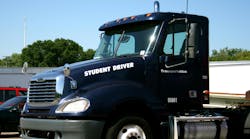Where are we going to find the next generation of truckers?
Key takeaways
- Declining interest in college creates an opportunity for trucking to attract younger workers seeking alternative careers.
- Early recruitment programs, internships, and community engagement help build a sustainable pipeline of drivers and techs.
- Positive onboarding and career experiences are essential to retain new entrants and reduce industry turnover.
I dove into the results of a Gallup poll released last month about people’s perceptions of the importance of a college education, and while they’re striking, they’re not surprising.
Just in the past 15 years, from 2010 to today, the percentage of people who reported viewing a college education as “very important” dropped from 75% to just 35%. Conversely, those viewing it as “not too important” jumped from 5% to 24%. (The remaining 40% of respondents said they still see college as “fairly important.”)
Those shifting attitudes about the importance, or lack thereof, of a college education were led by younger people, those 18-34, whose perceptions of higher education’s importance declined more rapidly than other age groups.
Attracting the next generation: Rethinking recruitment for younger talent
What do these numbers scream to me? Younger people are craving alternatives to traditional paths, traditional education, and traditional career choices. Currently, the average age of a new entrant CDL-holding professional truck driver is in their late 30s, and trucking jobs are often a third, fourth, or fifth career choice.
But we have an amazing opportunity as an industry and as individual companies to fill the vacuum of interest for this new generation of Americans, who are bored with the old and looking for something new.
If the Gallup numbers are accurate, now is the time to embrace and empower the programs to accelerate our reach to younger people, be intentional about recruiting them into our industry, and show them why trucking is the alternative they’re seeking. Our industry is teeming with both opportunities and needs, whether it be driving jobs, diesel technician jobs, or various in-office roles in operations, dispatch, sales, and recruiting.
My recent conversation with a recruiting manager at a fleet with locations across the country revealed that they have a program in place to recruit the children, siblings, cousins, friends, etc., of their current diesel tech employees. They can hire them directly out of high school when they are on their way to tech school, and they start recruiting them while they are still in high school. But they don’t.
The snag, they said, is that even though the program has the bones and is effective, as long as their recruiting department can fill a tech job with a traditional approach (i.e., through a job board, pipeline, applicant, etc.), they will not consider training a candidate out of high school for that position.
Isn’t that a lot like the driver population?
Right now, when a driving job opens up, we can fill it quickly with a driver who has plenty of experience. Our pipeline to younger people is mostly absent, both as an industry and at the company level, because, as I’ve written here in FleetOwner before, this is just the way we’ve always done it.
As the current driver population retires and ages out of our industry, what will happen when there is no backlog of new entrants to replace them?
Building career paths: from high school internships to long-term opportunities
We must be urgent right now about how we create and articulate a long-term career path by:
- Actively engaging in our communities to connect with young people and promote our careers and companies as lucrative, desirable, fulfilling, and worthy of their consideration. Think job fairs, hosting events at high schools and community colleges, events like parades, offering internships, hiring family members and friends of current employees, and more.
- Hiring younger people for roles other than driving and providing them with a clear path to become CDL holders during the brief period between high school graduation and being old enough to drive in interstate operations (think dock to driver and other similar programs that are already having success across the industry, especially at private fleets).
- Extending similar efforts to recruit and train diesel mechanics, who can begin interning or working in our shops while still in high school, without waiting until they turn 21 to become full-fledged technicians in our shops.
- Joining or supporting organizations like the Next Generation in Trucking Association, which does vital work in engaging with high schools and community colleges to implement trucking and CDL programs and build interest in trucking careers among younger people.
Last but not least, I am thinking of this in the context of a week-long series of conversations I had with upwards of hundreds of drivers live on SiriusXM’s Road Dog Trucking Radio, many of whom, unfortunately, said they would discourage young people from entering the industry. Why? Their own lived experiences as professional drivers and the sacrifices and struggles they faced in the industry.
As you and I both know, trucking jobs are lucrative, rewarding, and meaningful. To capture this next generation of drivers we so desperately need (and, again, who are actively searching for alternatives to traditional paths!), we must have a keen focus on the experiences of new entrants in our industry and make it one that’s positive and indicative of what a career here looks like.
I wrote in FleetOwner in 2022 about how corrosive the “earn your stripes” mentality is to our workforce and our industry. It applies to both driving jobs and in-office careers, but it’s especially damaging to those seeking the promise of a new career and a new life behind the wheel.
If we can’t fix that, our efforts to attract a new generation won’t yield much beyond the existing status quo: Hundreds of thousands of people enter trucking each year, and most of them cycle out before making it to their one-year mark.
We have a chance to do so much better, and we should seize it. Now is the time.
About the Author
Leah Shaver
Leah Shaver is president and CEO of The National Transportation Institute. NTI has tracked and analyzed professional driver and technician compensation and benefits data since 1995 utilizing proprietary research and surveys of for-hire motor carriers and private fleets. NTI tracks wages and benefits trends on a quarterly and annual basis with the National Survey of Driver Wages and the National Driver Wage Index, as well as other studies. Prior to joining NTI and 2015 and assuming ownership of the company in 2020, Shaver headed the HR and recruiting departments at a large midwestern-based for-hire motor carrier. She is also on the board of directors of the Next Generation in Trucking Association.



